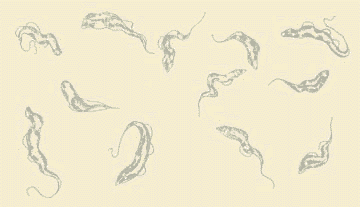

 |
 |
|||
| Cre-lox (floxed) systems for gene deletion (click here for non-floxed and earlier floxed tagging vectors) | |||||
General Comments The baseline reference for this system is CRE recombinase-based positive-negative selection systems for genetic manipulation in Trypanosoma brucei (2008) Scahill MD, Pastar I & Cross GAM. Molecular and Biochemical Parasitology 157:73-82. DOI PMC PMID. It is suggested that you read at least parts of this paper, especially the discussion! We have only used this system in bloodstream forms, although the Donelson lab demonstrated its utility (and toxicity) in procyclics (Barrett B, LaCount DJ & Donelson JE (2004) Trypanosoma brucei: a first-generation CRE-loxP site-specific recombination system. Exp Parasitol 106:37-44. DOI). The reported toxicity can probably be avoided by transiently expressing cre, or using the crippled expression vectors described below. The following comments were written after publication of the Scahill 2008 paper. We have since written another brief report Strategies to construct null and conditional null Trypanosoma brucei mutants using Cre-recombinase and loxP (2013) Kim, H-S, Li Z, Boothroyd, C & Cross, GAM, Molecular and Bochemical Parasitology in press, which describes additional constructs for gene deletion and conditional gene deletion, with or without epitope-tagging the gene to be deleted. The plasmids described in this later paper are listed below. The 'floxed' (flanked by lox) constructs listed here are the enhanced versions referred to in the discussion of the above paper. The most important features are: (1) the floxed constructs are available with 5 positive-selectable markers. The sequences of these have been checked but, at the time of writing, not all have been functionally tested for GCV sensitivity, nor have we tested the extent to which other than the HYG-TK and PUR-TK fusions are split after synthesis. Using the floxed vectors The floxed targeting vectors can be tested at the pyrimidine locus, after linearization with PvuII. The pyrimidine-targeting sites can be replaced with your targets of interest either by PCR amplification of the floxed cassette with long primers terminating in the construct sequences GATAAGCTTATAACTTCGTATAGCATACA (29 nt, the last 7 of which are from the 8-bp center of the lox sequence that is not palindromic) and GACCCACTTAGGATCCATAACTTCGTA (27nt, the last 11 of which are identical to 11 nt in the forward primer, but not complementary), or by cloning in longer targeting fragments to replace the PYR upstream and downstream targets. The efficiency of 'PCR targeting' can vary depending on the locus, as anecdotal and more precise experience (Oberholzer M, Morand S, Kunz S & Seebeck T. (2006) Mol Biochem Parasitol 145:117-20 DOI PMID) has evidenced. With the floxed cassettes, we (Cross lab: Hee-Sook Kim) have found that PCR-targeting the second allele can be especially inefficient, probably because of the TK homology within the floxed cassettes containing different positive selectable markers. This 'second allele problem' can be obviated in two ways: either treat with cre to eliminate the first floxed cassette prior to targeting the second allele, which can now be done with the same cassette, or (if the PCR oligonucleotides are still not working), the first floxed allele can be PCR-amplified using more distant flanking primers and this product, with its much longer flanking regions, can be used to target the second allele after cre treatment to eiminate the first floxed allele (or the PCR product could be cloned and the positive selectable markers switched via two of the unique flanking restriction sites, allowing both alleles to be targeted before cre-mediated excision). In case of difficulty targeting even the first allele, the pyrimidine targets in the provided vectors can be replaced with other PCR-amplified target loci. First, clone the downstream target sequence, with BamHI and SbfI ends into a pyrFEKO vector digested with the same enzymes, then clone the upstream target sequence, with PvuII and HindIII ends into a pyrFEKO vector digested with the same enzymes. Linearize the vector with PvuII plus SbfI. For either cloned or PCR oligo targeting, proceed as follows. Step 1 Transfect and select for drug resistance (hygromycin, puromycin, etc). You can probably avoid cloning prior to Steps 2 & 3. The original pLEW100-cre plasmid was provided by John Donelson (Trypanosoma brucei: a first-generation CRE-loxP site-specific recombination system (2004) Barrett B, LaCount DJ & Donelson JE. Experimental Parasitology 106:37-44. DOI) with his permission to distribute it along with the modified derivatives made by us. All the pLEW100 plasmids can be stably transfected, although for stable transfection we suggest using the one expected to have the least (essentially no) uninduced activity, which is pLEW100cre-EP1-6G. Although our paper showed data where this plasmid had slightly higher background than one with pLEW100cre-EPI, this was not predicted and was possibly due to clonal variation. A pLEW100cre-EP1-6G plasmid containing Luciferase gene showed no detectable activity (unpublished experiments by MDS). Any of the pLEW100 cre versions can be used for our recommended transient transfection expression of Cre. The version from which the Tet operator has been deleted is intended for transient use in Tet repressor-expressing cells, to avoid having to use tetracycline induction, which (in this case) would induce other tet-regulated insertions in the same cell line. Plasmid information and download | |||||
| Click the plasmid name to view or download a full-page illustration in pdf format. The illustration will open in a new window or a new tab. Illustrations show (in red) enzymes that are predicted to cut once. Right click (PC and Mac) or control click (Mac) the appropriate icon to download sequence files (Lasergene Seqbuilder or Genbank-formatted text). Click the WORD icon to open the GenBank-formatted file in a new window. Please inform me if any of the links give you the wrong files, or if you encounter any other problems. | |||||
|
To ensure continued availability of our plasmids, we have deposited the major ones with Addgene. Please use the link to the left to check availability and to request them. |
| PLASMID (pdf) |
Lasergene Seqbuilder | GenBank (text) | SELECTION | COMMENTS |
| pLEW100cre | Phleomycin | Published (the original plasmid from John Donelson's lab) We have verified the cre sequence in these plasmids. | ||
| pLEW100cre-EP1 | Phleomycin | Published. Use this construct for stable tetracycline-regulated low-level expression of cre recombinase | ||
| pLEW100cre-EP1-6G | Phleomycin | Published. Use this construct for stable tetracycline-regulated low-level expression of cre recombinase | ||
| pLEW100cre_del_tetO | Phleomycin | Unpublished. pLEW100cre with the tet operator deleted. This is the plasmid to use for transient cre expression in cells that express the tet repressor, so no need to add tetracycline | ||
| pyrFEKO-HYG | Hygromycin |
Unpublished (variant of constructs described in Scahill et al 2008) | ||
| pyrFEKO-PUR | Puromycin Ganciclovir |
Unpublished (variant of constructs described in Scahill et al 2008) | ||
| pyrFEKO-NEO | G418 |
Unpublished (variant of constructs described in Scahill et al 2008) | ||
| pyrFEKO-BLE | Phleomycin Ganciclovir |
Unpublished (variant of constructs described in Scahill et al 2008) | ||
| pyrFEKO-BSD | Blasticidin |
Unpublished (variant of constructs described in Scahill et al 2008) | ||
| Kim et al 2013 floxed knockout and conditional knockout vectors, and sources of epitope tags and markers | ||||
| pSY45 | Hygromycin |
The base for making conditional KO vectors using one of 5 positive selectable markers derived from the pyrFEKO or pHJ series and 4 possible epitope tags derived from pDS66-69 | ||
| pDS66 | Hygromycin | Triple HA epitopes to make tagged conditional KO vectors in pSY45 | ||
| pDS67 | Hygromycin | Triple MYC epitopes to make tagged conditional KO vectors in pSY45 | ||
| pDS68 | Hygromycin | GFP epitope to make tagged conditional KO vectors in pSY45 | ||
| pDS69 | Hygromycin | FLAG epitope to make tagged conditional KO vectors in pSY45 | ||
| pHJ17_HYG-TK-loxP | Hygromycin Ganciclovir |
Similar to pyrFEKO-HYG, above, but with tubulin and aldolase 5' & 3' UTRs | ||
| pHJ18_PUR-TK-loxP | Puromycin Ganciclovir |
Similar to pyrFEKO-PUR, above, but with tubulin and aldolase 5' & 3' UTRs | ||
| pHJ22_NEO-TK-loxP | G418 Ganciclovir |
Similar to pyrFEKO-NEO, above, but with tubulin and aldolase 5' & 3' UTRs | ||
| pHJ41_BSD-TK-loxP | Blasticidin Ganciclovir |
Similar to pyrFEKO-BSD, above, but with tubulin and aldolase 5' & 3' UTRs | ||
| pHJ42_BLE-TK-loxP | Phleomycin Ganciclovir |
Similar to pyrFEKO-BLE, above, but with tubulin and aldolase 5' & 3' UTRs | ||
| pHJ32_HYG-loxP | Hygromycin | Lacks TK, but cre is so efficient that negative selection for excision can be omitted | ||
| pHJ33_PUR-loxP | Puromycin | Lacks TK, but cre is so efficient that negative selection for excision can be omitted | ||
| Please see the in-situ tags page for more (earlier) floxed and unfloxed constructs for epitope tagging. | ||||